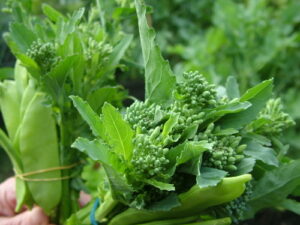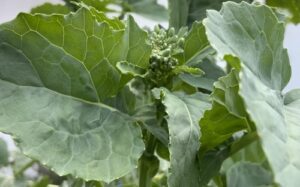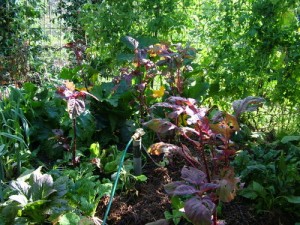Fruiting planting days today and tomorrow, but this time of year is the risky season for fruiting annuals. If I plant things that are frost, or even cold tender now, even in sub-tropical northern NSW, I am betting on a late start to winter. If I plant things that need the cold weather (like broad beans) I am betting on an early start.
I won’t bet on early yet – I’ll leave the broad beans for another month. My site is high and pretty nearly frost free, so broad beans are right on the margin anyway. If you live further south, or even in a cooler site, you might like to put in some broad beans now though. I’ll have an each way bet on late, planting out a small number of advanced seedlings of squash, zucchini, cucumbers, and beans, but not so many that I’ll be upset if an early frost knocks them off. I want to save space for peas and broad beans and cauliflowers and onions anyhow. And specially garlic. I really don’t want to be eating anything imported from China or Japan this year. Sadly Japanese people don’t have that luxury.
Too late for capsicums, chili or eggplants even as advanced seedlings, but I shall put in more seed of tomatoes. I have pulled back on tomatoes this year. I use them so much that I got a bit greedy. Last year’s tomatoes failed to thrive as well as they should – nothing specific, just plants that looked a bit bedraggled and keeled over sooner than they should and fruit that was a bit scanty and less resistant to pest attack. I put it down to a build up of soil bourne disease, caused by planting them in the same places too soon. This year I planted only in places that hadn’t had a tomato plant, or anything else in that family, for several years. It has meant I have had tomatoes for eating but not for bottling. So I am keen to keep at least a little supply coming through winter to see me through. By spring I will have given most of the garden a rest from tomatoes, and I should be able to plant bottling quantities again. It’s a good lesson, but one you’d think I would have learned by now!




crumbs – can’t believe it is broad beans again – my grip on reality (or time) is slim. Our tomatoes are still green and coming on and our eggplant are yet to fruit but I have put in a few winter veg already. Planning on trying your carrot onion approach with seeds this year. You say in your book to soad the carrot seed, then mix with onion seed and sand and sprinkle. Am I being dense in thinking but do you mix wet seed dry seed and dry sand? and then sprinkle by hand? Keen to get my first ever carrots since being a kid in Tassie.
x
It’s one of the main reasons I use a lunar planting calendar. Otherwise, time just gets away – I’m still planning to plant the spring things and its already autumn. And it’s counter intuitive – you are planting for the next season whilst harvesting from the last. Carrot seed germinates more reliably after a quick soak, onion doesn’t care. Dry sand is just to allow you to sow tiny seed thinly enough – if you are dexterous you can leave it out. These days too, I germinate the carrot-onion mix in the shadehouse too, especially over summer, though from now on you should be right with direct sowing. https://witcheskitchen.com.au/planting_carrots/
Linda, we’re having a strange time with tomatoes, and wondered if you might have any advice, please? The seedlings grow ok, and when they first go into the bed (brand new bed, no previous toms), they seem to be ok, but as the plant grows, the tops start to shrivel up and die off, and then the whole plant finally dies off. It’s really a puzzle. They were fine late last year, but near the end of last round, they just all started dying off, and now these new ones are not thriving either. We thought it was water, and have installed irrigation, and all the chicken crops (lucerne, millet etc) have taken off, but not the toms?
Other stuff seems to be ok, although we’ve had no luck with zucchinis and only piddling results with the cucumbers. Eggplant though is proving impossible to kill – now it’s getting water again, all the old plants have decided to flower again! Same with basil. It’s quite confusing…
Hi Celia, at a guess if your eggplants are doing well, I’d guess its not bacterial wilt but fusarium wilt. There’s a good wilt identification here. You can also tell bacterial wilt because if you cut the stem and put it in water, the water goes cloudy – you can actually see the bacterial spreading into the water. It doesn’t do you a huge amount of good to know anyhow, because in either case, the humid weather this year hasn’t helped – it’s less prevalent in drier years. The cure is: Water deeply and infrequently – get your plants drinking from deep and let the topsoil dry out regularly. Avoid tomatoes or other members of the family (eggplants, potatoes, capsicums) in the same spot for a while. And chose resistant varieties. Sometimes it takes a few years to find your treasured varieties – it’s why I recommend keeping a garden diary. Cherry tomatoes and self-sown wild sorts are often more resistant. One of my favourite tomato varieties came from a cherry tomato I found growing wild in decorative bed at a Visitor Information Centre! If you find a neighbour whose tomatoes are doing well, cadge seed! I have also been trying Early Peel this year, after my bad tomato year. It’s a Roma variety that’s supposed to be resistant to verticillium and fusarium wilts. Tropic has also been a good variety for me in the past.
Thanks for the advice, Linda! You’re absolutely right – the wilt we have looks just like the one in the photo you pointed us too. Bugger. Hopefully the new watering system we’ve put in will make a difference!
Our Romas in the front garden have the same affliction, Celia! I’m going to let that bed recover next year, thanks to your advice, Linda, and plant cherry tomatoes in the other front bed. Hopefully we’ll do better.
Happily, I planted Amish Paste tomatoes in the back garden in late January (against a south facing wall to give extra reflected heat) and they’re starting to fruit now. I’m hoping the next month will stay warm enough to get good fruit from them – I’ve known Sydney tomatoes to survive all winter in the right spot.